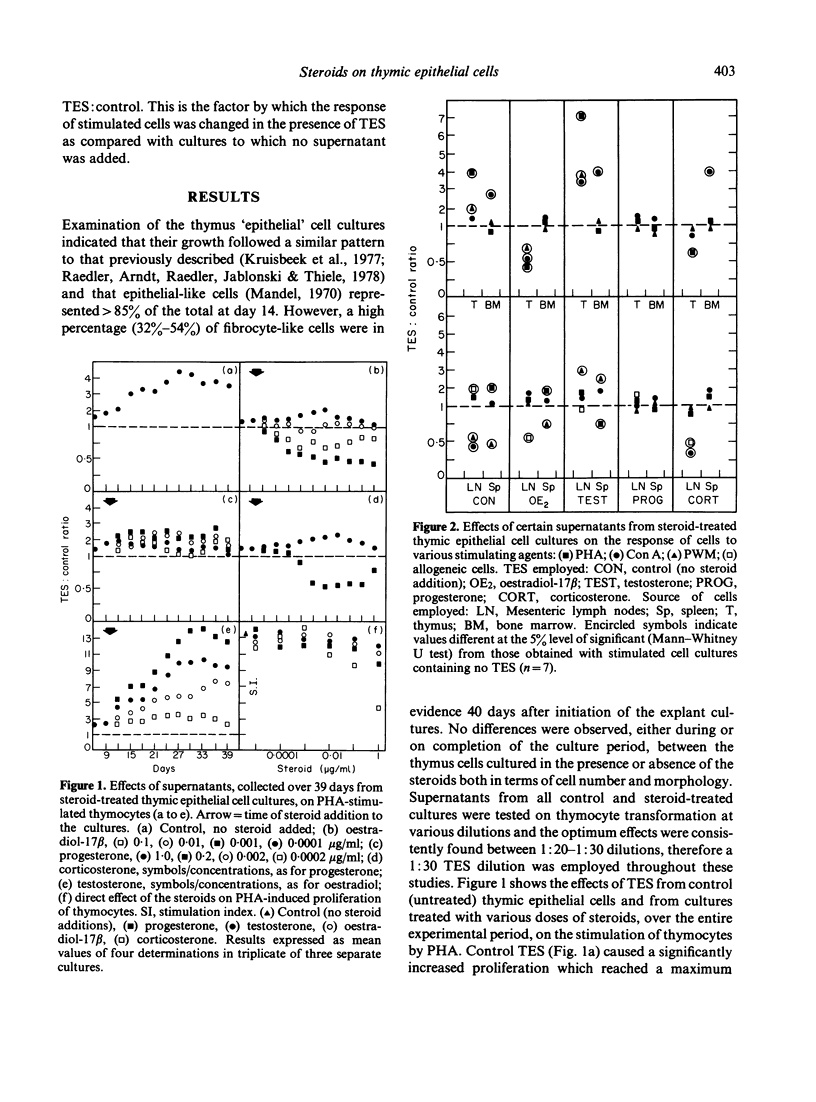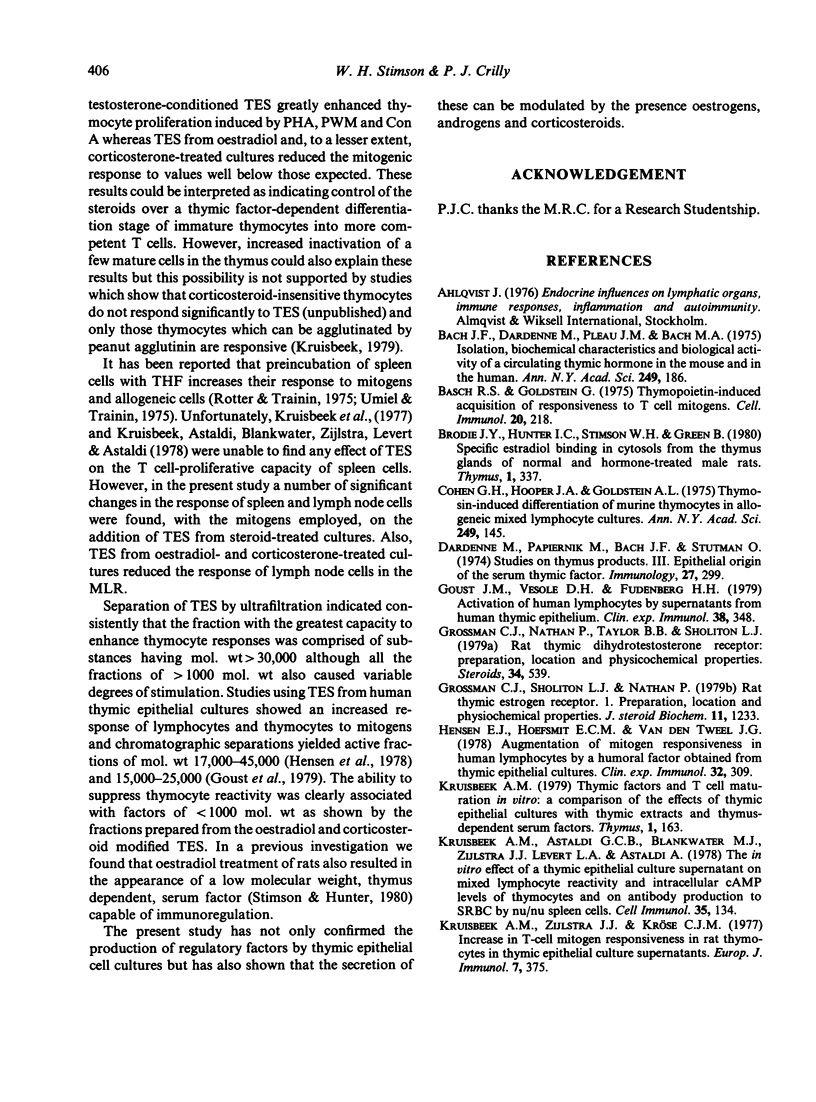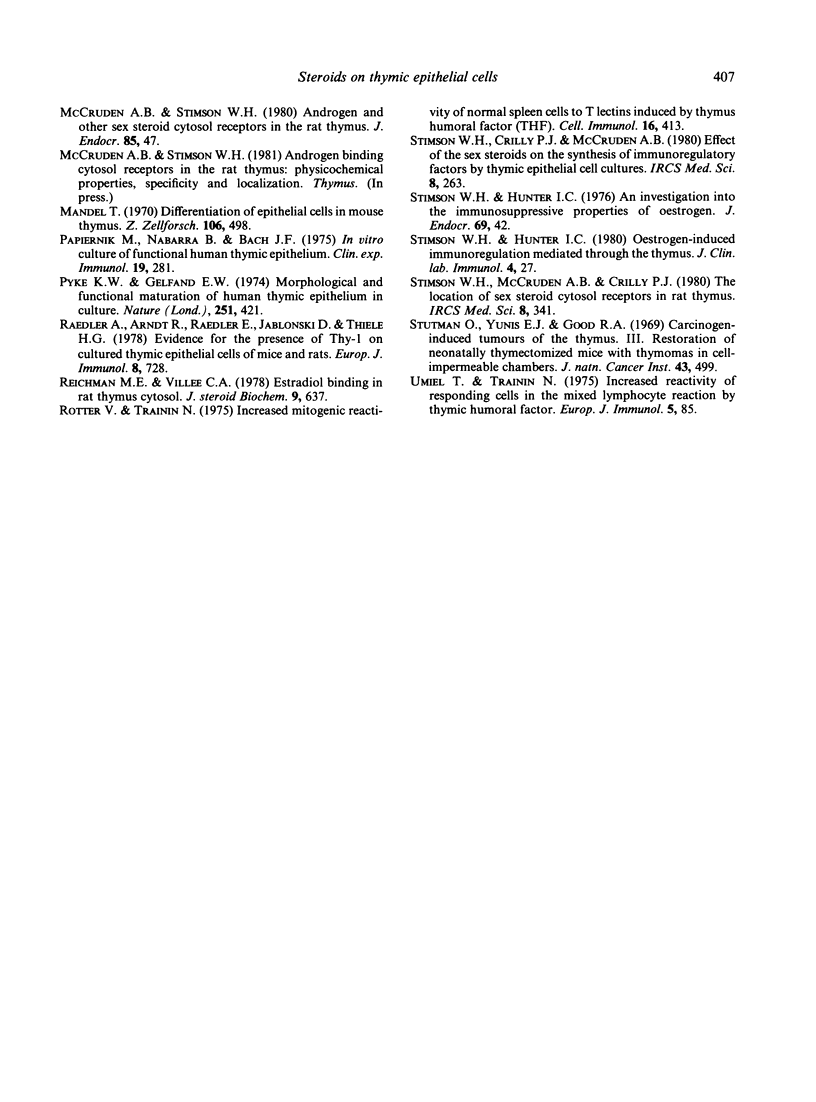Abstract
Rat thymic epithelial cells were cultured for 39 days in the presence of various concentrations of oestradiol, testosterone, progesterone and corticosterone and the supernatants assessed for effects on the stimulation of cells from the thymus, bone marrow, lymph nodes and spleen, with several agents. All the steroids, except progesterone, were found to significantly regulate the secretion of immunoregulatory factors by the epithelial cells at physiological levels but the effects were dose dependent. Fractionation of active supernatants indicated that the capacity to enhance or depress cellular proliferation was mainly associated with substances having molecular weights greater than 30,000 or less than 1000, respectively. This study supports the idea that certain steroids can influence the immune response indirectly through the thymus.
Full text
PDF






Selected References
These references are in PubMed. This may not be the complete list of references from this article.
- Bach J. F., Dardenne M., Pleau J. M., Bach M. A. Isolation, biochemical characteristics, and biological activity of a circulating thymic hormone in the mouse and in the human. Ann N Y Acad Sci. 1975 Feb 28;249:186–210. doi: 10.1111/j.1749-6632.1975.tb29068.x. [DOI] [PubMed] [Google Scholar]
- Basch R. S., Goldstein G. Thymopoietin-induced acquisition of responsiveness to T cell mitogens. Cell Immunol. 1975 Dec;20(2):218–228. doi: 10.1016/0008-8749(75)90099-4. [DOI] [PubMed] [Google Scholar]
- Dardenne M., Papiernik M., Bach J. F., Stutman O. Studies on thymus products. 3. Epithelial origin of the serum thymic factor. Immunology. 1974 Aug;27(2):299–304. [PMC free article] [PubMed] [Google Scholar]
- Goust J. M., Vesole D. H., Fudenberg H. H. Activation of human lymphocytes by supernatants from human thymic epithelium. Clin Exp Immunol. 1979 Nov;38(2):348–355. [PMC free article] [PubMed] [Google Scholar]
- Grossman C. J., Nathan P., Taylor B. B., Sholiton L. J. Rat thymic dihydrotestosterone receptor: preparation, location and physiochemical properties. Steroids. 1979 Nov;34(5):539–553. doi: 10.1016/s0039-128x(79)80015-x. [DOI] [PubMed] [Google Scholar]
- Grossman C. J., Sholiton L. J., Nathan P. Rat thymic estrogen receptor--I. Preparation, location and physiochemical properties. J Steroid Biochem. 1979 Sep;11(3):1233–1240. doi: 10.1016/0022-4731(79)90190-0. [DOI] [PubMed] [Google Scholar]
- Hensen E. J., Hoefsmit E. C., Van Den Tweel J. G. Augmentation of mitogen responsiveness in human lymphocytes by a humoral factor obtained from thymic epithelial cultures. Clin Exp Immunol. 1978 May;32(2):309–317. [PMC free article] [PubMed] [Google Scholar]
- Kruisbeek A. M., Astaldi G. C., Blankwater M. J., Zijlstra J. J., Levert L. A., Astaldi A. The in vitro effect of a thymic epithelial culture supernatant on mixed lymphocyte reactivity and intracellular cAMP levels of thymocytes and on antibody production to SRBC by Nu/Nu spleen cells. Cell Immunol. 1978 Jan;35(1):134–147. doi: 10.1016/0008-8749(78)90133-8. [DOI] [PubMed] [Google Scholar]
- Kruisbeek A. M., Kröse T. C., Zijlstra J. J. Increase in T cell mitogen responsiveness in rat thymocytes by thymic epithelial culture supernatant. Eur J Immunol. 1977 Jun;7(6):375–381. doi: 10.1002/eji.1830070610. [DOI] [PubMed] [Google Scholar]
- Kruisbeek A. M. Thymic factors and T cell maturation in vitro: a comparison of the effects of thymic epithelial cultures with thymic extracts and thymus dependent serum factors. Thymus. 1979 Nov;1(3):163–185. [PubMed] [Google Scholar]
- Mandel T. Differentiation of epithelial cells in the mouse thymus. Z Zellforsch Mikrosk Anat. 1970;106(4):498–515. doi: 10.1007/BF00340288. [DOI] [PubMed] [Google Scholar]
- Papiernik M., Nabarra B., Bach J. F. In vitro culture of functional human thymic epithelium. Clin Exp Immunol. 1975 Feb;19(2):281–287. [PMC free article] [PubMed] [Google Scholar]
- Pyke K. W., Gelfand E. W. Morphological and functional maturation of human thymic epithelium in culture. Nature. 1974 Oct 4;251(5474):421–423. doi: 10.1038/251421a0. [DOI] [PubMed] [Google Scholar]
- Raedler A., Arndt R., Raedler E., Jablonski D., Thiele H. G. Evidence for the presence of Thy-1 on cultured thymic epithelial cells of mice and rats. Eur J Immunol. 1978 Oct;8(10):728–730. doi: 10.1002/eji.1830081011. [DOI] [PubMed] [Google Scholar]
- Reichman M. E., Villee C. A. Estradiol binding by rat thymus cytosol. J Steroid Biochem. 1978 Jul;9(7):637–641. doi: 10.1016/0022-4731(78)90175-9. [DOI] [PubMed] [Google Scholar]
- Rotter V., Trainin N. Increased mitogenic reactivity of normal spleen cells to T lectins induced by thymus humoral factor (THF). Cell Immunol. 1975 Apr;16(2):413–421. doi: 10.1016/0008-8749(75)90130-6. [DOI] [PubMed] [Google Scholar]
- Stimson W. H., Hunter I. C. Oestrogen-induced immunoregulation mediated through the thymus. J Clin Lab Immunol. 1980 Jul;4(1):27–33. [PubMed] [Google Scholar]
- Stutman O., Yunis E. J., Good R. A. Carcinogen-induced tumors of the thymus. 3. Restoration of neonatally thymectomized mice with thymomas in cell-impermeable chambers. J Natl Cancer Inst. 1969 Aug;43(2):499–508. [PubMed] [Google Scholar]
- Umiel T., Trainin N. Increased reactivity of responding cells in the mixed lymphocyte reaction by a thymic humoral factor. Eur J Immunol. 1975 Feb;5(2):85–88. doi: 10.1002/eji.1830050203. [DOI] [PubMed] [Google Scholar]


